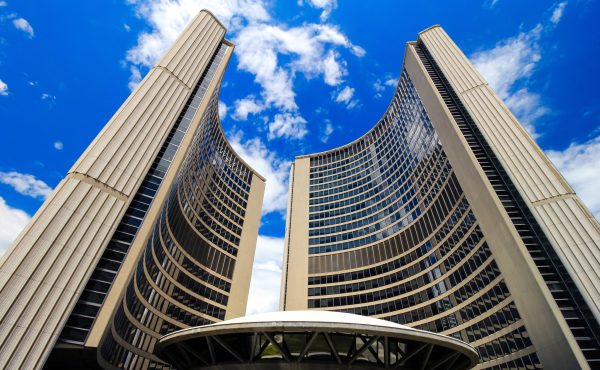
Today in the Toronto Star’s op-ed section, Martin Knelman argues that Toronto is finally getting the funds it needs to compete with Montreal as Canada’s seat of cultural avant-garde. He even ups the urban-rivalry ante by writing that “Toronto’s cultural all-stars [by which Knelman means the AGO, Luminato and the ROM, all of which have received millions from politicians of late] are upstaging Montreal’s, which is the equivalent of the Leafs winning the Stanley Cup by beating the Canadiens in overtime.”
Millions or no, I have to say that from where I sit, Toronto still has a long ways to go before it snatches Montreal’s cultural crown. In terms of cultural access, Hogtown is way behind La Belle Ville, even more so than our beleaguered pucksters are lagging the Habs.
Why? Because $75 million-plus in funds that our big-name TO institutions and fests are receiving isn’t tied to creating equitable admission fees.
Check this: Admission to the Montreal Museum of Fine Arts (MTL’s most ROM-like venue) is free for the permanent collection, and fee’d only for temporary shows. The ROM? Still $20 for both.
Over at the Musee d’art Contemporain de Montreal (MTL’s more AGO-like institution) the comparison is just as dramatic: Where the new AGO will have a more reasonable admission policy than the ROM ($18, with free entrance on Wednesday evenings) it still pales to that of the MACM, which charges just $8 for an adult admission and still has their own free entrance scheme—also, coincidentally, on Wednesday evenings.
Similarly, Luminato is still far from totally affordable. As far as I could see on their website, half the events are free, while the other half range in price up from $10 to $125.
Luminato just released a list of “community outreach” events today, which is of course better than nothing, but there are still issues. As Kate Hammer reports in today’s Globe and Mail, the access programs that the AGO and the ROM do have are often confusing for intended users. While the existence of these programs sounds great to donors and access advocates, it’s clear that they have a long way to go before they can deliver culture in a way that actually provides access to all Torontonians.
“Vive le Toronto artistique,” Knelman suggests, and that will work for some in our city.
Yet for the many who can’t afford it, Toronto culture might as well be on life support. Oui ou non?




9 comments
I think Knelman has been reading too much Jenny Holzer. Money [i]does not necessarily [/i]create taste.
No comment on Holzer in relation to this article, but when I discovered her it was one of those cathartic Art Moments when some artist is doing something that completely makes sense and is almost like it fills some gap in your mind, and lets you understand the world better.
You can see a Holzer on the wall of the Tate Modern in London, by the elevator — for free.
Uuuhhh..glad to hear about Luminato being recognized as a big success, and a little pissed about the difference in admission fees (although MBA and Md’AC are *much* smaller than the ROM and AGO). But when in the last 30 years has Montreal been Canada’s cultural centre? If a city has the national ballet and opera companies, the largest museums in the country, the national broadcaster, arguably the world’s most important film festival and (to use to old-but-true cliche) probably the biggest theatre scene in the English-speaking world other than New York and London…is it really competing with anybody else in Canada? I know Montreal definitely still has the lead in modern dance, but that’s gotta be it.
She is the heir to Barbara Kruger.
good call on the fact that even though the buildings and branding are new and shiny but that most people can afford to blow that kinda money on a trip to the museum.
I always loved how in Montreal (and New York…and London…) you could just stroll into the museum if the afternoon got to be damp or on a cold morning and them just leave. No pressure to turn it into a day trip and get your money’s worth.
I think one might think that if one thinks “culture” comes from large brick-mortar institutions like AGO. No matter how many free passes are given out at citizenship ceremonies, that will remain true for a lot of native and non-native Torontonians. How much culture could be generated if you used city-owned community centres to hold exhibitions and events and downloaded $75m directly to artists, rather than reinforce the “blue chip”/”big iron” arts venues?
After all, the AGO/ROM funding was essentially on top of previous funding, as the managements essentially got initial capital and then money to cover their overruns. This at a time when Scarborough hospitals are being told “we gave you your allowance, it’s not our fault you overspent”.
As for the funding injection leading to comparison with Quebec, I am reminded of the old sporting saying that “form is temporary, class is permanent”. A few surprise bailouts of Luminato and the like isn’t the creation of a well-funded cultural oasis. Let’s see what happens next year when the economy starts hurting.
Mark: I really appreciate you pointing out the comparison to the hospitals situation.
I personally love the arts, work in them, etc. but I have to say that this spending on symbolic (and overblown) architectural projects around art is really disappointing. While it may win recognition abroad (as in Conde Nast’s recent pick of the Crystal as one of the “seven wonders of the world”) fact is that museums are founded (and should be funded and planned) as for community first, tourists second. These are not contradictory goals per se, but have ended up being so in the TO formulation.
I also have been thinking about the Montreal model of “Maisons de Culture” for some time–basically all-in-one libraries/theatres/galleries scattered throughout the city. It seems a way to really showcase culture to all citizens, rather than just the ones who happen to live downtown.
And yay for the Holzer/Kruger shoutouts!
There is an intriguing parallel between so-called arts funding and what we see in other areas like transit. There’s always lots of money to build things — money that goes to architects and engineers and construction companies — but not so much to actually provide “art” or to operate these palaces.
Remember the outrage when the city bailed out a small theatre company? They actually produced something, more than can be said for the money that went into a lot of building projects.
I lived in Montreal for several years but am hard-pressed to think of anything there that has the scale or scope of the ROM.